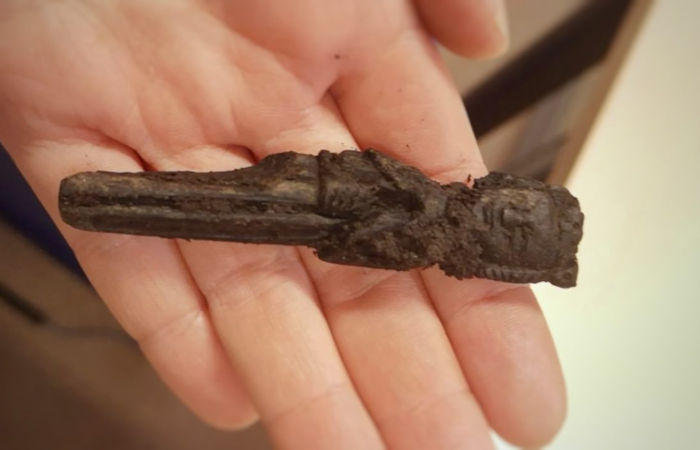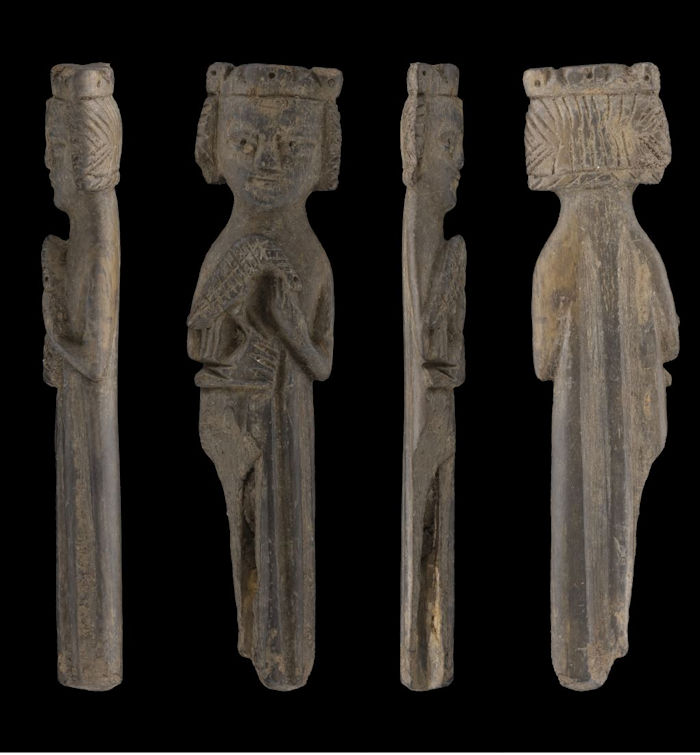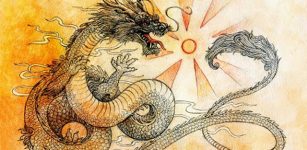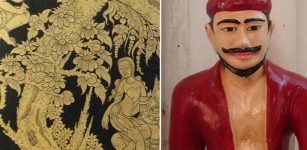Strange Medieval Figurine With A Crown On The Head And A Falcon On The Arm – Is It A King Or A Queen?
Jan Bartek - AncientPages.com - A small carved figure was recently unearthed during the excavation of the medieval town of Oslo, Norway. The figure depicts a person in robes and crown with a falcon perched on his arm. But is it a king or a queen?
A small but significant figure from the 13th century. Exposed to daylight for the first time after laying in the ground for eight centuries. Photo: NIKU.
Working as an archaeologist in Norway during winter is challenging.
For the lucky ones, there’s digging within tents which provide a stable and warm environment. For those who are unlucky to work outside the tents, however, the lows of minus twelve degrees is no joke.
Fortunately, there are some perks to the job.
King Of The Rubbish Heap?
“I was about to finish up. It was snowing heavily, I was cold and a little tired of digging the refuse layer”, says Ann-Ingeborg Floa Grindhaug, one of the archaeologists working outside of the tent in The Medieval Park project in Oslo. Out of the ground she pulled with frozen fingers what she thought was a large fishbone. Bad light conditions made identification of the bone difficult.
“I thought it had a strange shape”, she continues. When she turned the object around, she was surprised to be staring at the smiling face of a figure with a crown on the head and a falcon on the arm. Perhaps a king?
“There was no one nearby that I could show it to”, says Ann-Ingeborg. Luckily, I warmed up as I ran to find a colleague to share the excitement with.
One Of The Earliest Visual Representations Of Falconry In Scandinavia
“There is no doubt that the figure wears a crown”, says Kjartan Hauglid, art historian and researcher at NIKU.
“But it is harder to decide if it is a king or a queen”, he adds.
The falcon itself is not an indicator of gender. Women were also falconers in the medieval period.
“The design of clothing shows that it is from the middle of the 13th century. The hair or head linen also fits the date. Head linen was fashionable for married women at this time”, the researcher elaborates.
“This is among Scandinavia’s earliest visual representations of falconry”, Hauglid says.
The figure is 7.5 cm long and has a flat oval cross section. It is an early Scandinavian representation of the noble sport of falconry. Photo: Ann-Ingeborg Floa Grindhaug and Jani Causevic, NIKU.
“It was probably made at a workshop in Oslo and is among the most important artifacts found in Oslo in recent years”, he adds. “We only know a handful of similar finds with falcons from Northern Europe, several depicting women.”
The lower half of the figure is hollow, which indicates it could have been a shaft for a weapon or tool. In the 1920s, a similar knife shaft was found in Oslo. Unfortunately, there is little information about this find, but the hairstyle makes Hauglid believes it is slightly younger.
The newly discovered object was found just a stone’s throw from Kongsgården, the royal residence, which was in use up until the start of the 14th century. Maybe it belonged to a noble person, if not the king himself.
Detailed Craftsmanship
The figure is 7.5 cm long and made of organic material, either bone or antler. It is decorated on both sides and has a flat oval cross-section. A crown sits on top of a contemporary 13th-century hairstyle or possibly a head linen. The face is gentle and smiling with marked pupils. The figure wears a long robe.
A falcon rests on the figure’s right arm which appears to be gloved. Its head is bent down towards the figure’s left raised hand. The plumage is illustrated with an engraved lattice pattern. The falcon’s eye is also drilled.
Precious Bird
Regional archaeologist for Vestfold and Telemark and falconry expert Ragnar Orten Lie says “When a falcon sits on the falconer’s arm, it often wears a hood, which calms the falcon. These hoods were first introduced to Europe by Frederick II towards the middle of the 13th century. The bird could also have been kept calm by feeding it or stroking it with a feather”, he explains.
Perhaps this is what the carving portrays. After all, you didn’t want it to get loos and fly off.
“A trained falcon today costs between 16 000 and 34 000 pounds. Similarly trained birds also reached comparably high prices in the medieval period.”
“The cheapest price for an untrained Norwegian falcon in the 13th century was 240 silver longcross pennies, which is the same as the price of 4-6 cows or 1-2 horses. These birds had a 70% mortality rate”, Orten Lie adds.
This practice was only for the elite, inferring high status. Falconry with the smaller birds – kestrel and sparrowhawk – was also practiced by females. The kestrel became a symbol of romance.
A warrior aristocracy that engaged in falconry clearly demonstrated their superiority.
King Håkon Håkonsson Gifted Falcons
We do not know for sure who the figure depicts or if it is male or female. There are several that fit the profile. The date of the object, however, coincides with the reign of Håkon Håkonsson, king of Norway in the period 1217-1263. He is known as a major player in the field of falconry.
See also: More Archaeology News
King Håkon was considered a learned man and spent a lot of time and energy “civilizing” his men after the model of European court culture. As part of alliance-building, he gifted falcons far beyond the European continent. Alliances were entered into and maintained through marriages and gifts. The most precious gift a Norwegian king could give was a falcon.
Since falconry was a common royal and noble practice throughout the Middle Ages, we cannot say for certain that the figure portrays King Håkon. However, dating and context indicate that it is a strong possibility.
Written by Jan Bartek - AncientPages.com Staff Writer






















